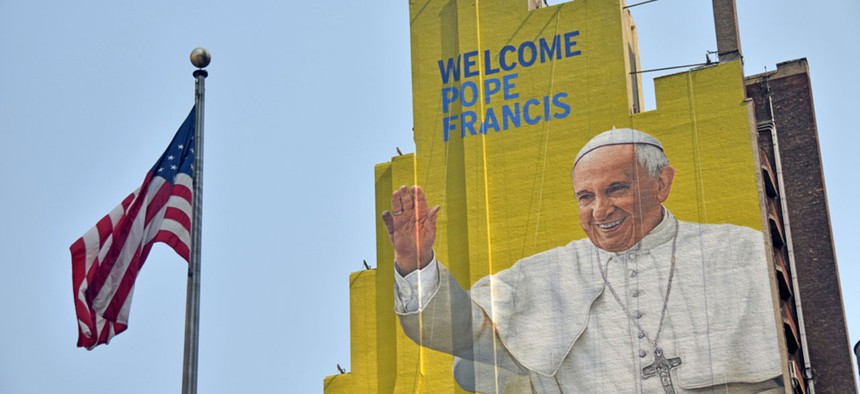
A building in New York shows a painting of Pope Francis in anticipation of his visit to the United States. Ivan Cholakov/Shutterstock.com
In Anticipation of Pope Francis, Senate Democrats Push Sweeping Energy Plan
Party leaders are unveiling legislation that would include carbon savings and kill big oil tax breaks, though the plan has little chance to move in a GOP-controlled Congress.
Top Senate Democrats are trying to seize the political offensive on energy as Pope Francis, who issued a detailed call to action on climate change in June, is making a high-profile trip to Washington.
Senior lawmakers are releasing a wide-ranging energy plan Tuesday that sets a new “carbon-savings goal” to help tackle climate change, stating that it’s U.S. policy to cut the country’s carbon emissions by at least 2 percent annually through 2025.
Senate Minority Leader Harry Reid and Democratic leader-in-waiting Chuck Schumer are among the lawmakers scheduled to join Maria Cantwell, the top Democrat on the Senate’s energy panel, at a Tuesday press conference to promote the plan. Ron Wyden, the top Democrat on the Finance Committee, is also slated to be there.
While the plan is little more than a messaging effort in a GOP-controlled Congress, Schumer told The New York Times that it could be a template for legislation that Democrats will push if they regain Senate control in the 2016 elections.
“A plan that looks something like this is going to be high on the next Congress’s agenda,” Schumer told the paper.
The 437-page plan swipes at the oil industry by nixing a suite of tax incentives for the biggest oil companies, like Exxon and Shell. It would end write-offs for drilling costs and big companies’ ability to claim a lucrative deduction on domestic manufacturing income, among other incentives.
It also sets new fees for some oil and gas wells, and curtails a program that allows royalty-free production in deep Gulf of Mexico waters.
Elsewhere, the bill would create a new system of tax incentives for low-carbon electricity and transportation-fuel production that would streamline the existing patchwork of credits, creating a more flexible system that’s based on the level of emissions cuts. (It’s similar to a green-tax overhaul that then-Senate Finance Chairman Max Baucus floated in late 2013.)
Democrats are also dusting off a longstanding plan to mandate more energy savings in the power system by requiring that electric and natural-gas utilities cut energy use by 20 percent by 2030.
As for the 2 percent annual carbon-cutting target, if met, it would enable at least a 30 percent cut from 2005 levels by 2025, given that U.S. emissions are already down about 10 percent over the last decade. (Although, they’ve ticked back upslightly in 2013 and 2014.)
The Obama administration, in a landmark climate agreement with China last year and in a more recent pledge to the United Nations, has vowed to reduce U.S. greenhouse-gas emissions by 26 to 28 percent by 2025 compared with 2005 levels.
The big bill contains a wide array of other measures in topics including cybersecurity; improving energy infrastructure, such as natural-gas distribution systems; initiatives to modernize the electric grid; boosting R&D into greener cars and trucks; and much more.
The measure arrives as Democrats are battling GOP efforts to dismantle President Obama’s climate agenda, especially first-time EPA carbon-emissions rules for power plants.
However, the bill does not include climate policies long-sought by environmentalists as well as many Democrats that would explicitly put a price on carbon emissions, either through a carbon tax or a cap-and-trade system.
(Top image via Ivan Cholakov / Shutterstock.com)







